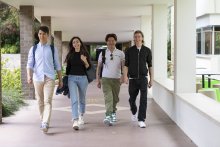

Why choose this course?
Take your talent for photography to new heights with this qualification. Learn how to take spectacular shots in a range of contexts and how to manipulate the environment around you to help with your photography.
During this course, you will develop your skills and knowledge in taking and developing photographs and composing, capturing, processing and enhancing images using various techniques. The course covers production of digital images, camera techniques, lighting, studio and location work. You will develop skills in business, publishing systems, markets and photographic illustration and learn to consider variables including client needs and aesthetics.
You will have the opportunity to develop skills in industrial and scientific photography, fine art photography or photojournalism. Upon graduation you will have gained a varied skill set aligned to industry standards, such as producing commercial, portrait and stock photo images, research skills and the knowledge to manage media assets.
You can continue your studies for a further year in the CUA60420 Advanced Diploma of Creative Product Development – Photography.
Career opportunities
- Freelance Photographer
- Photographic Assistant
- Photojournalist
-
A Folio is required for this course. For up to date information on folio requirements please refer to our website: tafeinternational.wa.edu.au/folio-requirements.
-
An IELTS score (academic) of 6.0 with no band score less than 5.0 or equivalent.
-
Equivalent to Australian Year 11.
There may be further semester intakes available for enrolment. You can view any further intakes when you submit your online application(opens in a new tab).
For information about pathways from TAFE to university, view our Pathways to university page.
How to apply
Apply to study at TAFE in six steps:
- find a course;
- check entry requirements;
- submit an application;
- accept your offer and pay;
- apply for your student visa; and
- receive your visa and come to Australia for your studies.
Build your own course guide
Select the study areas, courses and topics you like. Get your custom guide by email!
Download study area guide(opens in a new tab)
Contact us(opens in a new tab)
TAFE International Western Australia (TIWA) is the Registered Training Organisation (RTO) and Commonwealth Register of Institutions and Courses for Overseas Students (CRICOS) provider, for the delivery of training to international students, enrolled in a TAFE course in Western Australia. This nationally recognised course is delivered by a Western Australian TAFE college on TIWA's behalf. TIWA retains responsibility for the quality of the training and assessment delivered by the TAFE colleges and for the issue of certification documentation to students.

